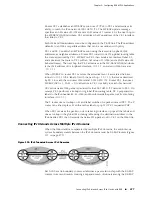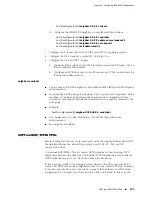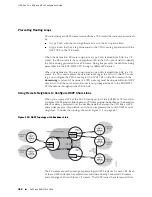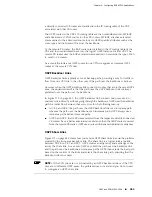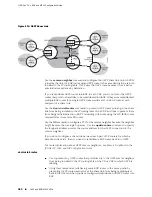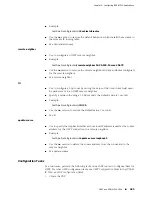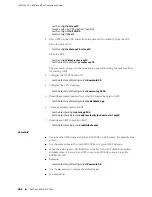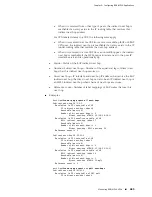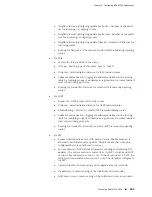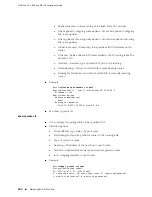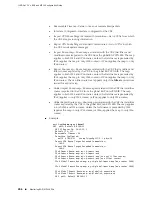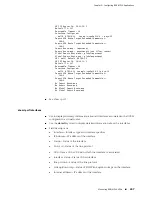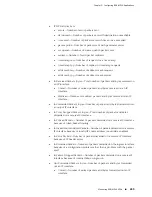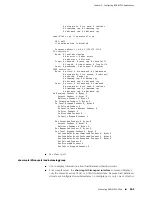
domain-tag
■
Use to set the VPN route tag for an OSPF VRF on a PE router.
■
The default value is a 32-bit number based on the AS number of the BGP/MPLS
VPN backbone, with the first 16 bits set to 1110 0000 0000 0000, followed by
the 16 bits representing the AS number.
■
Example
host1:default:ospf2(config-router)#
domain-tag 1200
■
Use the
no
version to restore the default value.
■
See domain-tag.
Configuring VPLS
You can configure one or more instances of the Virtual Private LAN Service (VPLS),
referred to as
VPLS instances
, on the router. VPLS is a BGP-MPLS application that has
much in common with BGP/MPLS VPNs. VPLS employs a layer 2 virtual private
network (VPN) to connect multiple individual LANs across a service provider’s MPLS
core network. The geographically dispersed multiple LANs functions as a single virtual
LAN.
For details about configuring and using VPLS, see “Configuring VPLS” on page 589.
Configuring L2VPNs
You can configure one or more instances of a Layer 2 Virtual Private Network (L2VPN),
referred to as
L2VPN instances
, on the router. An L2VPN, sometimes referred to as
Virtual Private Wire Service (VPWS), is a BGP-MPLS application that has much in
common with BGP/MPLS VPNs. L2VPNs employ layer 2 services over MPLS to build
a topology of point-to-point connections that connect end customer sites in a VPN.
L2VPNs provide an alternative to private networks that have been provisioned by
means of dedicated leased lines or by means of layer 2 virtual circuits that employ
ATM or Frame Relay. L2VPNs enable the sharing of a provider’s core network
infrastructure between IP and L2VPN services, reducing the cost of providing those
services.
For details about configuring and using L2VPNs, see “Configuring VPWS” on page 657.
Monitoring BGP/MPLS VPNs
To view BGP/MPLS VPN settings, you can issue the following
show
commands as
well as any of the
show ip bgp
commands and some of the
show bgp ipv6
commands
described in “Configuring BGP Routing” on page 3. See “Configuring MPLS” on
page 267, for information about
show
commands to monitor MPLS settings.
Use the debug ip mbgp command to get information about problems with BGP or
the network.
Configuring VPLS
■
487
Chapter 5: Configuring BGP-MPLS Applications
Summary of Contents for BGP
Page 6: ...vi ...
Page 8: ...viii JUNOSe 11 1 x BGP and MPLS Configuration Guide ...
Page 37: ...Part 1 Border Gateway Protocol Configuring BGP Routing on page 3 Border Gateway Protocol 1 ...
Page 38: ...2 Border Gateway Protocol JUNOSe 11 1 x BGP and MPLS Configuration Guide ...
Page 234: ...198 Monitoring BGP JUNOSe 11 1 x BGP and MPLS Configuration Guide ...
Page 236: ...200 Multiprotocol Layer Switching JUNOSe 11 1 x BGP and MPLS Configuration Guide ...
Page 542: ...506 Monitoring BGP MPLS VPNs JUNOSe 11 1 x BGP and MPLS Configuration Guide ...
Page 544: ...508 Layer 2 Services Over MPLS JUNOSe 11 1 x BGP and MPLS Configuration Guide ...
Page 610: ...574 Virtual Private LAN Service JUNOSe 11 1 x BGP and MPLS Configuration Guide ...
Page 624: ...588 VPLS References JUNOSe 11 1 x BGP and MPLS Configuration Guide ...
Page 680: ...644 Virtual Private Wire Service JUNOSe 11 1 x BGP and MPLS Configuration Guide ...
Page 724: ...688 Monitoring MPLS Forwarding Table for VPWS JUNOSe 11 1 x BGP and MPLS Configuration Guide ...
Page 725: ...Part 6 Index Index on page 691 Index 689 ...
Page 726: ...690 Index JUNOSe 11 1 x BGP and MPLS Configuration Guide ...





